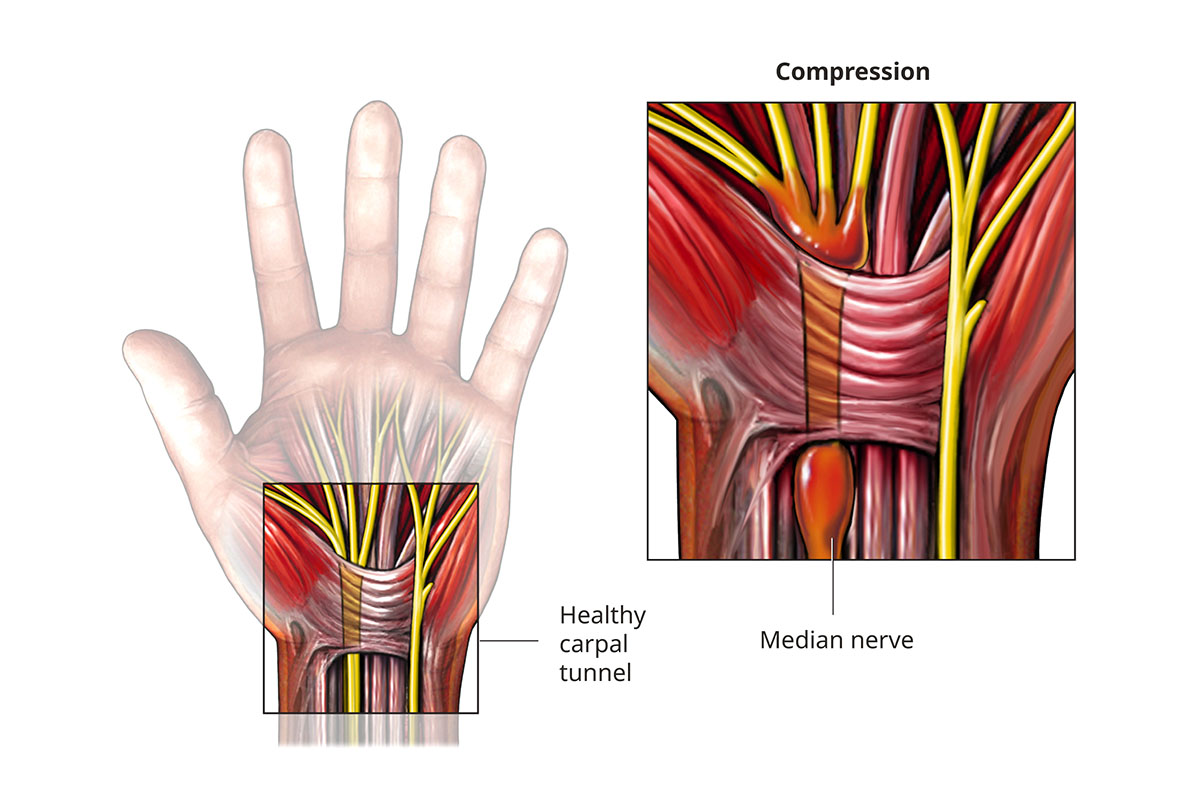Carpal Tunnel Syndrome

OHSU specialists can offer you relief for carpal tunnel syndrome, a condition that causes hand pain and numbness. You’ll find:
- A team approach to care, with specialists from areas such as neurology, neurosurgery, plastic/reconstructive surgery and orthopaedics working together.
- Surgeons with advanced training from some of the nation’s top medical centers.
- Rehabilitation specialists who can teach you how to more comfortably function at work and home.
Understanding carpal tunnel syndrome
What is carpal tunnel syndrome?
Carpal tunnel syndrome is a peripheral nerve disorder in which a nerve becomes pinched or compressed. Peripheral nerves connect the body with the central nervous system (the brain and spinal cord).
This syndrome involves the carpal tunnel nerve, also known as the median nerve. This nerve runs along the inner arm to the thumb and three middle fingers. When it’s pinched, lack of blood flow can cause nerve damage that leads to hand pain and numbness.
Carpal Tunnel Syndrome

Who gets carpal tunnel syndrome?
Carpal tunnel syndrome is the most common entrapment neuropathy, or pinched nerve. It affects an estimated 3-5% of U.S. adults, most older than 30. It is more common in women because their carpal tunnel — the passage for the median nerve — is smaller.
People who use repetitive hand movements during daily routines are most at risk. Hair stylists, computer programmers or assembly line workers, for example, are more likely to develop it.
What causes carpal tunnel syndrome?
Most of the time, the exact cause of carpal tunnel syndrome is unknown. Studies have found, however, that using the hands for certain repetitive work motions can increase risk. Deformities or injuries to the small bones in the wrist can also compress the nerve.
Conditions that can cause or worsen carpal tunnel syndrome include:
- High blood sugar and diabetes, which may damage nerve fibers.
- Thyroid disease, which may cause fluid buildup that puts pressure on the median nerve.
- Fluid retention during pregnancy or menopause, which can compress the nerve.
Symptoms
- Numbness in the fingers or palm
- Tingling or “pins and needles”
- Burning pain
- Weakness, particularly when pinching the thumb and fingers
You may notice more severe symptoms at night if you sleep with your wrists flexed or bent, which pinches the nerve.
Diagnosing carpal tunnel syndrome
In about 10% of U.S. cases, carpal tunnel syndrome is misdiagnosed. It may be confused with arthritis, for example. At OHSU, we have the experience to give you an accurate diagnosis and to recommend the best treatment.
Tests for carpal tunnel syndrome
If we suspect carpal tunnel syndrome, we’ll start by doing a physical exam and asking you about your medical history. Tests to see if you nerves are working properly include:
Electromyography: Your doctor sends a mild electric current to a needle placed in a muscle. It measures how well the nerve supplies electrical signals that cause the muscle to contract.
Nerve conduction velocity test: This test, also called a nerve conduction study, stimulates the nerve and measures how fast an electrical impulse moves through it.
Learn more about tests for nerve disorders.
Carpal tunnel syndrome treatments
Medication: For mild symptoms, we may prescribe anti-inflammatory medications such as ibuprofen to relieve pain. Corticosteroid injections can also reduce inflammation.
Splinting or bracing: A splint can prevent wrist motion to reduce nerve injury and pain. You may wear it at night or while working for a few weeks if your symptoms are mild to moderate.
Rehabilitation therapy: OHSU hand therapy experts can help you learn to change how you move, avoiding the strain that causes pain and injures the nerve.
Surgery: In severe cases, surgery can release pressure on the nerve. This almost always provides permanent relief. Depending on your symptoms and anatomy, your doctor may recommend:
- Endoscopic surgery: In this minimally invasive procedure, your surgeon uses small incisions and tools to check for nerve damage and relieve pressure on the nerve.
- Open surgery: Your surgeon makes an incision in the palm to expose the nerve and relieve pressure. Doctors prefer this method in some cases because it gives the surgeon a clear view of the carpal tunnel. Recovery may take longer, and the palm may be tender for a few weeks.
Learn more
- Carpal Tunnel Syndrome, American Society for Surgery of the Hand
- Carpal Tunnel Syndrome, American Academy of Orthopaedic Surgeons
For patients
Referral: To become a patient, please ask your doctor for a referral.
Locations
Parking is free for patients and their visitors.
We offer clinics for nerve conditions on our Marquam Hill and South Waterfront campuses.
Refer a patient
- Refer your patient to OHSU.
- Call 503-494-4567 to seek provider-to-provider advice.